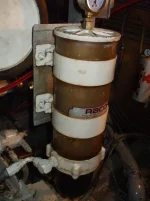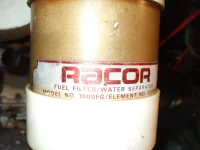Have done a bit of online research on this subject. Advice ranges from snake oil treatments (chemical) to pulling the tank, dumping and cleaning (not practical). Seems the correct way to do this would be to pump out as much as possible all the fuel and water into a barrel. Drop a dessicant bag into the tank to dry out all the remaining water, pour in biocide and refill with clean fuel. However, seems like a lot of work and expense. Guess if the fuel tank had been near empty at the time it became contaminated, this would be the most practical option. However, with 60 gallons of fuel and being at a marina, it may be a bigger project than I want to take on.
After all the advice, I guess my plan is to attempt to "suck" out the water and let the Racors do the rest. Options for sucking out the water...i) Diesel Tank Snake Absorber (
http://b3cfuel.com/products/diesel-tank-snake-water-absorber) or ii)"snaking" a hose or dip tube to the bottom of the tank and pumping out the water (as recommended by others here). Has anyone tried or used a B3C Fuel Tank Snake? Can I use my oil changing pump to pump out the water? Can't see why it would be a problem. The problem I am not able to get my head around is that 1/2 gallon of water is about 115 cu. in. which is 4.8 (call it 5") cubed. However, the length and width of the tank is easily 36" x 24" which would imply that once settled at the bottom, a 1/2 gallon of water would be equivalent to less than a 1/2 inch (1/6" to be exact) of water. My question is...Is it realistic to think that I will be able to suck out less than 1/2 inch of water using a dip tube? I guess the point is any water sucked out is a good thing. Isn't this really just something the Racors can handle over time?
So the issue with leaving water in the bottom of the tank is algae bloom. Solution...biocide! Should be sufficient? Right?
Seems the concern with leaving the seperation to the Racor is the risk of water slipping by and getting into the injectors causing them to foul from steam and leaving shrapenel in the cylinders. All not good...(then I will really be wishing I had drained and dried the tank). However, I'm not convinced this a serious concern for my situation. Remember...this is an ancient (1981 model) Detroit Diesel 671, not a highly tuned Cummins or Cat where tolerances are probably much less forgiving). These motors have over 3000 hours and 35 years of life. Surely, during that time there has been some bad fuel and water mixed into the system (if not from condensation alone). Obviously the Racors do there job. It is also my suspicion that it would take a lot of fuel abuse (contaminants/water) over many hours of operation to blow off the tips of the injectors. However, to confirm, I plan to contact injector manufacturers for some tech support on this issue and will report back.
I have attached some photos of my Racors. Says Fuel/Water Seperator on the label so presume it means these are the spinning type. Don't know if the filters are coalescing, but if spinners presume so.
Since I have twin diesel, my plan is to only run the contaminated fuel from the reserve tank through one motor (thus not risking two) and return to the reserve until it has all been consumed or at least down to enough where I can siphon off the rest and not care. However, I will only do this after I have made an attempt to first drain (suck out) some of the water that should have settled to the bottom. How much time should I give it to settle? Thinking maybe a couple of days.
So that's the plan...suck, run, and drain filters. Seems consistent with most of the advice I have received here, but would welcome any further input or concerns with this approach.
Thank you all for your responses and helpful advice!



